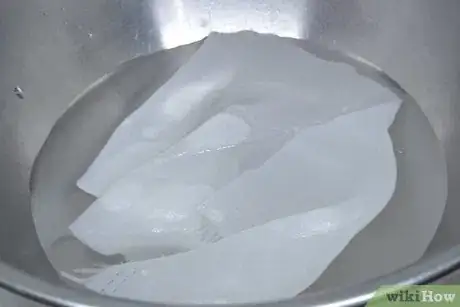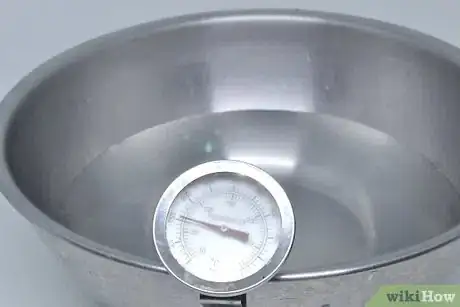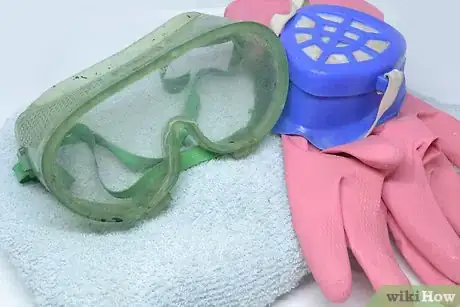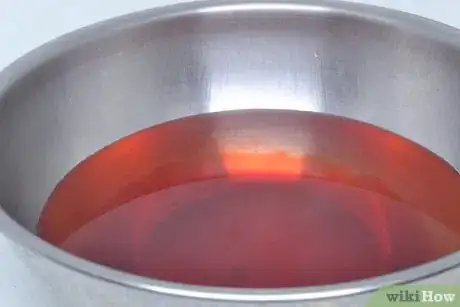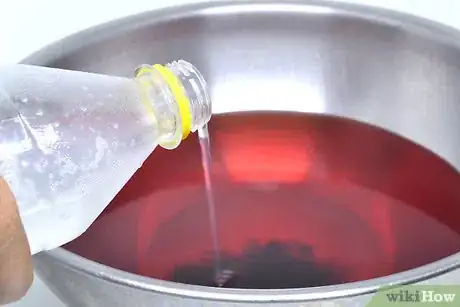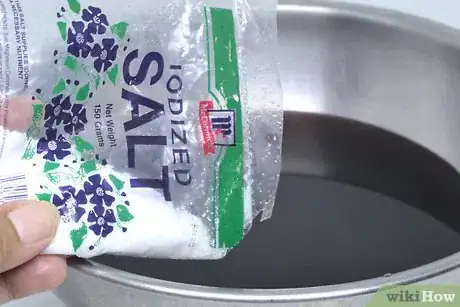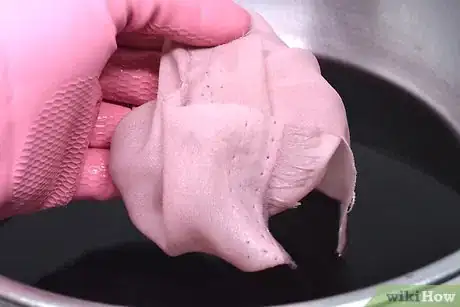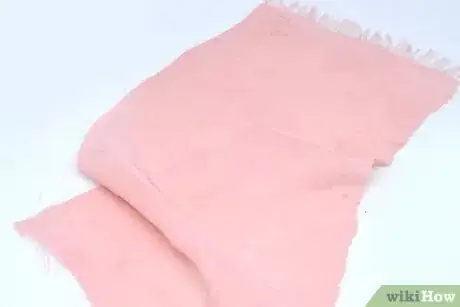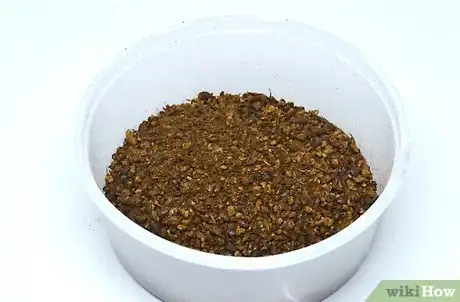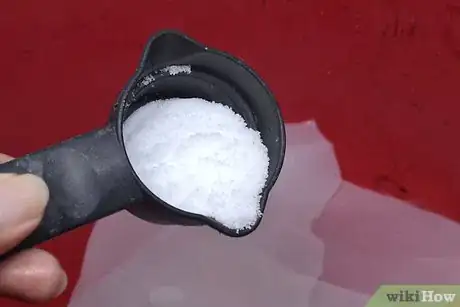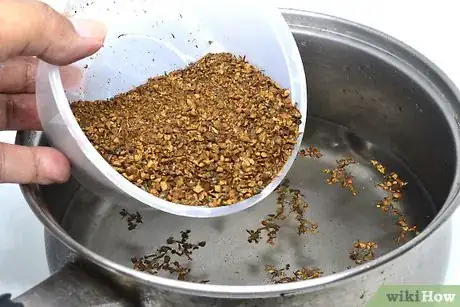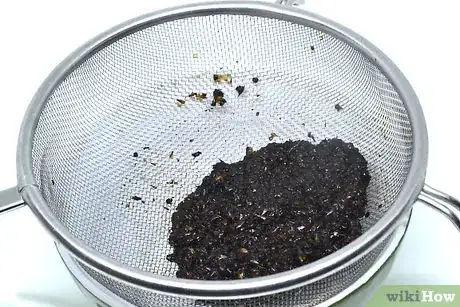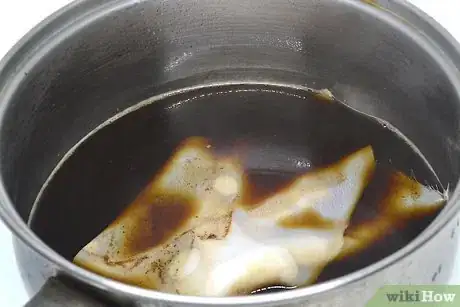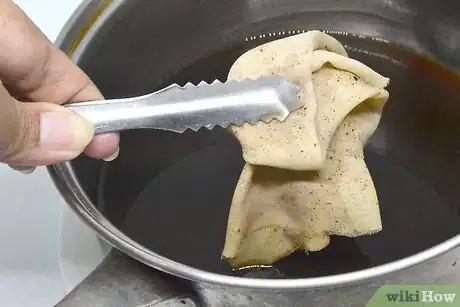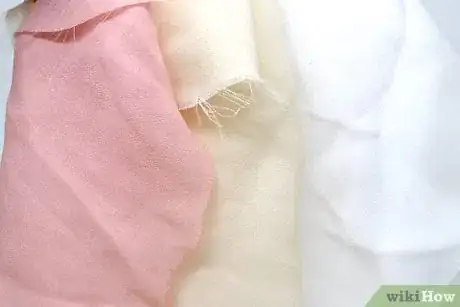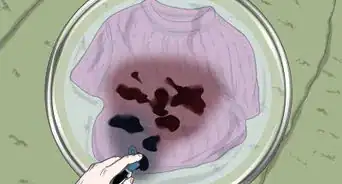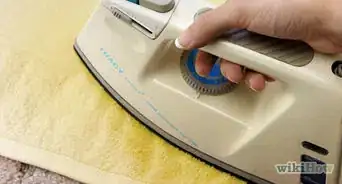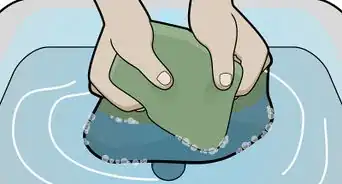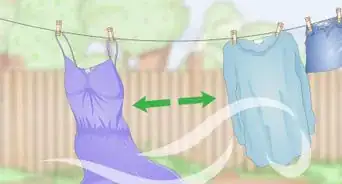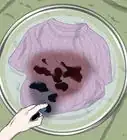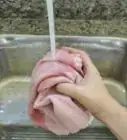This article was co-authored by wikiHow Staff. Our trained team of editors and researchers validate articles for accuracy and comprehensiveness. wikiHow's Content Management Team carefully monitors the work from our editorial staff to ensure that each article is backed by trusted research and meets our high quality standards.
There are 7 references cited in this article, which can be found at the bottom of the page.
This article has been viewed 28,878 times.
Learn more...
Because the term 'chiffon' actually refers to a weaving technique, the way you dye it actually depends on what fibers were used to create the material. Luckily, we'll show you how simple it is to figure out what the dye and techniques that will work best for your fabric!
Steps
Using Acid Dyes
-
1Purchase an acid dye online or at your local department or craft store. Jacquard Acid, RIT, Dylon, and idye are popular choices. Read the packaging to select the proper dye for your fabric.
- When determining how much dye to purchase, plan to use approximately 1 tablespoon (15 mL) of dye per pound (0.45 kg) of fabric to achieve a medium shade of color.[1]
-
2Prewash your fabric to remove dirt and stains. It’s important that your fabric is clean before you begin the dying process. Even if the item you are dying is brand new, it will need to be washed to remove dirt and oil from fingerprints and promote even coloring.[2]
- Typically chiffon fabric should be washed by hand or in the washing machine on the delicate cycle set to cold.[3]
- Your fabric will need to be wet prior to dying it, so plan to start your dying project as soon as it’s finished washing.
Advertisement -
3Fill a sink or bin with very hot water. Use a stainless steel kitchen sink (ceramic sinks may discolor from the dye) or a large bucket or bin to make your dye bath. The water should be near boiling or very hot tap water. Add enough water to cover the fabric and allow it to float freely.[4]
-
4Cover your work area with a drop cloth to protect it from the dye. The chemicals contained in fabric dyes can permanently stain surfaces and can be very harmful to users.[5]
- Use old towels if you don’t have a drop cloth.
- Put on safety glasses or goggles, gloves, and a dust mask to protect yourself.
-
5Measure the liquid or powdered dye and pour it into the water. Follow the directions on the package of the product you have chosen. The directions will tell you how much dye to add depending on the weight of your fabric. In general, you can add more dye for darker, deeper colors; and add less dye for lighter, more subtle shades.[6]
- It’s a really good idea to start with less dye and add more as needed. This is much easier to control than trying to dilute or lighten the mixture if you make it too dark.
- You can test the shade by placing a few drops of the dyed water on dry paper towel.[7] If the color isn’t dark enough, add a little more dye to the water until you achieve the desired color.
-
6Add 1⁄4 cup (59 mL) of vinegar per gallon (3.8 L) of dye for silk chiffon. Add 1 cup (240 mL) of vinegar for large projects that use more than 3 gallons (11 L) of solution. The vinegar acts as a mordant, which helps the fabric absorb the dye and helps with more even coloring.[8]
- Alternatively, you can use citric acid instead of the vinegar. Replace each 1⁄4 cup (59 mL) of vinegar with 1 teaspoon (4.9 mL) of citric acid.[9]
-
7Add 1⁄4 cup (59 mL) of salt per gallon (3.8L) of dye for cotton chiffon. Add 1 cup (240 mL) of salt for all projects that use more than 3 gallons (11 L) of solution. The salt helps the fabric absorb the dye and helps with more even color distribution.[10]
-
8Put the wet fabric into the dye bath and gently stir it with a spoon. Use a stainless steel spoon to constantly stir the fabric for at least 5-10 minutes. After that, stir it every few minutes up to 30 minutes. For really dark colors, you may need to soak and stir your fabric up to 1 hour.[11]
- If the dye doesn’t seem to be absorbing very well, add another 1⁄4 cup (59 mL) of salt or vinegar, or 1 teaspoon (4.9 mL) of citric acid to the water.
- Keep in mind that the fabric will fade a little bit after you rinse it. To help with this, soak it until it is a little darker than what you want the final color to be.
-
9Remove the fabric from the dye bath and rinse it with warm water. It’s easiest to run the fabric underneath warm running tap water. Gradually decrease the temperature until the water is cool and continue rinsing the fabric until the water runs clear.
- If the dye solution was mixed properly, there shouldn’t be very much dye and the runoff should be mostly clear.[12]
- Be careful not to agitate or twist the fabric too much while you are rinsing it.
-
10Wash and dry your freshly-dyed fabric. Use a mild detergent to wash your fabric by hand, or set your washing machine to a cold delicate cycle. The dyed piece should be washed alone to prevent it from bleeding onto other items.[13]
- Subsequent washes should be done in cold water as well.
Dying Chiffon Naturally
-
1Prewash your chiffon fabric to remove dirt and stains. It’s important that your fabric is clean before you begin the dying process. If possible, it’s best to use fabric that has been washed numerous times because it tends to have less wax than new fabric.[14]
- For silk chiffon, wash the item in a mild detergent. For cotton chiffon, use soda ash to get the best results.
- Your fabric will need to be wet prior to dying it, so plan to start your dying project as soon as it’s finished washing.
-
2Choose your desired color and a natural material to make your dye. Note that some materials do not produce the same color dye as their original form, and not all plants and foods will work as dyes.[15] Here are some effective natural choices based on the desired color:
- Blue: red cabbage, elderberries, red mulberries, blueberries, purple grapes
- Brown: acorns, coffee, dandelion roots, oak bark, tea
- Green: artichokes, grass, spinach, peppermint leaves, lilacs, peach leaves
- Grey-black: Blackberries, walnut hulls
- Orange: carrots, onion skins
- Pink: berries, cherries, red and pink roses, avocado skins and seeds
- Red-brown: pomegranates, beets, hibiscus
- Red-purple: basil leaves, huckleberries
- Yellow: bay leaves, marigolds, sunflower petals, dandelion flowers
- No matter which plant material you choose, it should always be fresh and ripe, and crushed or chopped into small pieces.[16]
-
3Soak the chiffon fabric in a mordant for 1 hour. A mordant works to help the fabric absorb the color more deeply and evenly. The type of mordant you use depends on the type of material you are using for the dye.[17]
- Use 1⁄2 cup (120 mL) of salt to 8 cups (1.9 L) of water for berries.
- Use 1 part vinegar to 4 parts water for plants and all other materials.
-
4Simmer your dying material in a large pot with water for 1 hour. There should be about twice as much water as there is plant material. The amount of plant material you use is largely experimental. In general, to get a medium shade of color, aim for a one-to-one ratio of dying material to the weight of the fabric.[18]
- Use a stainless steel or glass pot to avoid staining.
-
5Strain the dying material. Pour the contents of the pot through a kitchen strainer or mesh screen into a large bowl or jug. Gently press the dying material against the strainer or screen to release any excess liquid.[19]
- Return the liquid to the pot on the stove.
-
6Place the chiffon fabric in the pot and simmer it for 1 hour. Use a spoon to gently stir the fabric occasionally. This will help the dye reach all of the fabric so the end color is even.[20]
-
7Turn the heat off and allow the fabric to continue to soak for a richer color. The longer the fabric soaks, the darker the color will be. Keep in mind that the fabric will be lighter when it dries.[21]
- You may even soak the fabric overnight to achieve a really deep, rich color.
-
8Remove the chiffon fabric from the water and wash it in cold water. Gently squeeze the excess liquid from the fabric. Do not twist or wring it. Wash your freshly-dyed fabric in cold water by hand or on the delicate cycle and lay it flat or hang it up to dry.[22]
- Subsequent washes should be done in cold water as well.
-
9Finished.
Warnings
- It is very important that you wear protective gear when handling chemical dyes. Always wear a dust mask, safety glasses, and gloves to protect yourself from the dangerous chemicals.⧼thumbs_response⧽
References
- ↑ http://www.pburch.net/dyeing/FAQ/how_much_dye.shtml
- ↑ https://www.marthastewart.com/1110589/fit-be-dyed
- ↑ https://www.goodhousekeeping.com/institute/a22485/caring-for-delicate-clothes/
- ↑ https://www.marthastewart.com/1110589/fit-be-dyed
- ↑ https://joybileefarm.com/colour-your-woold-how-to-dye-wool-with-weak-acid-dyes/
- ↑ https://joybileefarm.com/colour-your-woold-how-to-dye-wool-with-weak-acid-dyes/
- ↑ https://www.marthastewart.com/1110589/fit-be-dyed
- ↑ https://www.marthastewart.com/1110589/fit-be-dyed
- ↑ https://joybileefarm.com/colour-your-woold-how-to-dye-wool-with-weak-acid-dyes/
- ↑ https://www.marthastewart.com/1110589/fit-be-dyed
- ↑ https://www.marthastewart.com/1110589/fit-be-dyed
- ↑ https://joybileefarm.com/colour-your-woold-how-to-dye-wool-with-weak-acid-dyes/
- ↑ https://www.marthastewart.com/1110589/fit-be-dyed
- ↑ https://grist.org/living/go-all-natural-with-fabric-dye-for-fabulous-earthy-colors/
- ↑ https://grist.org/living/go-all-natural-with-fabric-dye-for-fabulous-earthy-colors/
- ↑ https://www.diynatural.com/natural-fabric-dyes/
- ↑ https://grist.org/living/go-all-natural-with-fabric-dye-for-fabulous-earthy-colors/
- ↑ https://grist.org/living/go-all-natural-with-fabric-dye-for-fabulous-earthy-colors/
- ↑ https://www.diynatural.com/natural-fabric-dyes/
- ↑ https://www.diynatural.com/natural-fabric-dyes/
- ↑ https://littlegreendot.com/how-to-dye-fabric-with-natural-dyes/
- ↑ https://littlegreendot.com/how-to-dye-fabric-with-natural-dyes/

